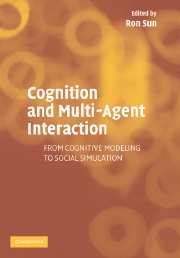Book contents
- Frontmatter
- Contents
- List of Contributors
- Preface
- PART 1 INTRODUCTION
- PART 2 OVERVIEWS OF COGNITIVE ARCHITECTURES
- PART 3 MODELING AND SIMULATING COGNITIVE AND SOCIAL PROCESSES
- 5 Cognitive Architectures, Game Playing, And Human Evolution
- 6 Simulating A Simple Case Of Organizational Decision Making
- 7 Cognitive Modeling of Social Behaviors
- 8 Cognitive Agents Interacting in Real and Virtual Worlds
- 9 Modeling Social Emotions and Social Attributions
- 10 Communicating and Collaborating with Robotic Agents
- 11 Behavior-Based Methods for Modeling and Structuring Control of Social Robots
- 12 Evolution of a Teamwork Model
- 13 Sociality in Embodied Neural Agents
- 14 Cognitive Architecture and Contents for Social Structures and Interactions
- PART 4 A SYMPOSIUM
- Index
7 - Cognitive Modeling of Social Behaviors
Published online by Cambridge University Press: 15 December 2009
- Frontmatter
- Contents
- List of Contributors
- Preface
- PART 1 INTRODUCTION
- PART 2 OVERVIEWS OF COGNITIVE ARCHITECTURES
- PART 3 MODELING AND SIMULATING COGNITIVE AND SOCIAL PROCESSES
- 5 Cognitive Architectures, Game Playing, And Human Evolution
- 6 Simulating A Simple Case Of Organizational Decision Making
- 7 Cognitive Modeling of Social Behaviors
- 8 Cognitive Agents Interacting in Real and Virtual Worlds
- 9 Modeling Social Emotions and Social Attributions
- 10 Communicating and Collaborating with Robotic Agents
- 11 Behavior-Based Methods for Modeling and Structuring Control of Social Robots
- 12 Evolution of a Teamwork Model
- 13 Sociality in Embodied Neural Agents
- 14 Cognitive Architecture and Contents for Social Structures and Interactions
- PART 4 A SYMPOSIUM
- Index
Summary
INTRODUCTION
The driving theme of cognitive modeling for many decades has been that knowledge affects how and which goals are accomplished by an intelligent being (Newell, 1991). But when one examines groups of people living and working together, one is forced to recognize that whose knowledge is called into play, at a particular time and location, directly affects what the group accomplishes. Indeed, constraints on participation, including roles, procedures, and norms, affect whether an individual is able to act at all (Lave & Wenger, 1991; Jordan, 1992; Scribner & Sachs, 1991).
To understand both individual cognition and collective activity, perhaps the greatest opportunity today is to integrate the cognitive modeling approach (which stresses how beliefs are formed and drive behavior) with social studies (which stress how relationships and informal practices drive behavior). The crucial insight is that norms are conceptualized in the individual mind as ways of carrying out activities (Clancey 1997a, 2002b). This requires for the psychologist a shift from modeling only goals and tasks – why people do what they do – to modeling behavioral patterns – what people do – as they are engaged in purposeful activities. Instead of a model that exclusively deduces actions from goals, behaviors are also, if not primarily, driven by broader patterns of chronological and located activities (akin to scripts).
This analysis is particularly inspired by activity theory (Leont'ev, 1979). Although acknowledging that knowledge (relating goals and operations) is fundamental for intelligent behavior, activity theory claims that a broader driver is the person's motives and conceptualization of activities. Such understanding of human interaction is normative (i.e., viewed with respect to social standards), affecting how knowledge is called into play and applied in practice.
- Type
- Chapter
- Information
- Cognition and Multi-Agent InteractionFrom Cognitive Modeling to Social Simulation, pp. 151 - 185Publisher: Cambridge University PressPrint publication year: 2005
- 6
- Cited by



